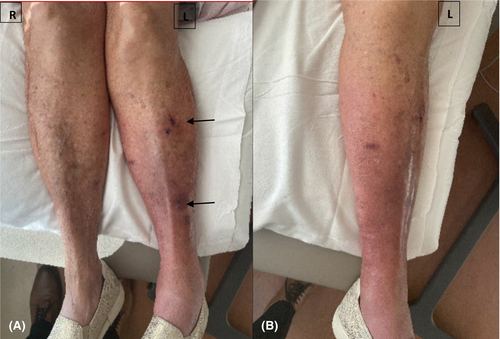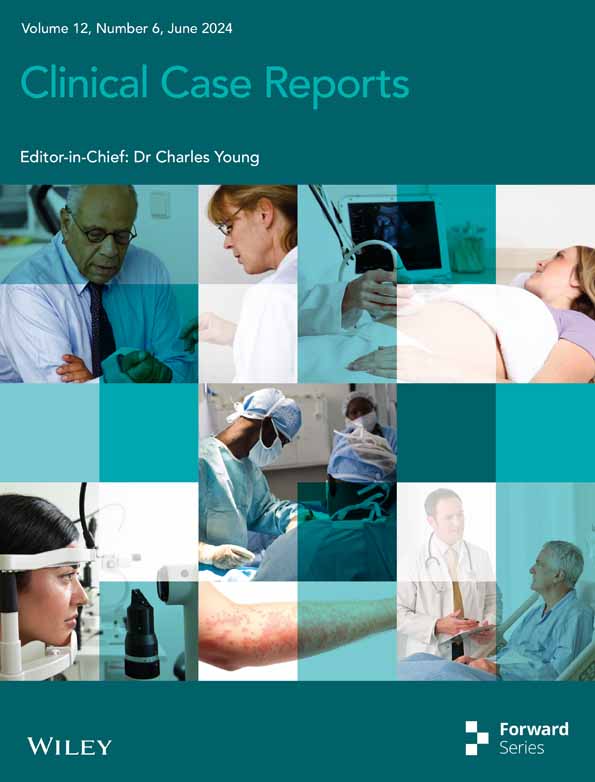Myroids odoratum bacteremia: A rare clinical isolate presented as a soft tissue infection
Key Clinical Message
Myroides odoratus infection, a rare gram-negative bacillus, predominantly affects immunocompromised patients and presents with diverse clinical manifestations. Antibiotic resistance poses challenges in determining appropriate treatment. This case underscores successful management of Myroides odoratus cellulitis complicated by bacteremia with dual antibiotic therapy, emphasizing the importance of timely recognition and susceptibility testing for effective treatment strategies.
1 INTRODUCTION
Myroids odoratum, previously known as Flavobacterium odoratum, is a rare infection first identified in 1929.1, 2 In the literature, a total of 104 cases have been documented to date.3-5 These cases present with diverse clinical manifestations, including urinary tract infections, pneumonia, soft tissue infections, intracranial infections, and sepsis,3, 4 predominantly occurring in immunocompromised patients. The limited data and reported antibiotic resistance have made it challenging to determine appropriate antibiotic treatments. This case highlights Myroids odoratum cellulitis, complicated by bacteremia, successfully managed with dual antibiotic therapy.
2 CASE HISTORY AND EXAMINATION
A 90-year-old woman with a significant medical history of coronary artery disease, takotsubo cardiomyopathy, and hypertension presented with a five-week history of redness, warmth, and swelling in her left leg. The symptoms initially started after a dog scratch, followed by exposure to water in a swimming pool. A few days prior to the ER presentation, the patient was seen at an urgent care clinic, where blood work, including cultures, was obtained, and the patient was started on Keflex. However, her symptoms progressed to include generalized fatigue, lower limb weakness, and a persistent low-grade fever. Upon evaluation in the emergency department, the patient was hemodynamically stable. Examination revealed swelling, warmth, and poorly demarcated redness in the left lower limb, as shown in Figure 1A,B. The rest of her examination was unremarkable.

3 METHODS
Blood cultures that were obtained a few days ago grew Flavobacterium odoratum, prompting the initiation of cefepime and ciprofloxacin. New cultures were obtained, the patient was given fluids and admitted to the regular nursing floor for further management. A few days later, the susceptibility results indicated sensitivity to meropenem, trimethoprim-sulfamethoxazole, cefepime, and piperacillin-tazobactam, with intermediate sensitivity to ciprofloxacin and resistance to gentamicin, tobramycin, and amikacin.
4 CONCLUSION
The patient demonstrated clinical improvement, with subsequent cultures showed no bacterial growth for 48 h. Consequently, the antibiotics were de-escalated to trimethoprim-sulfamethoxazole based on the sensitivity results.
5 DISCUSSION
Myroides odoratus is described as a gram-negative bacillus with aerobic and nonfermentative characteristics.2 Typically, this bacterium is recognized as an opportunistic pathogen, mainly impacting individuals with compromised immune systems. Its significance stems from its infrequent occurrence and resistance to multiple drugs. Uzer Khan et al. conducted a review study that included 97 cases and five self-reported cases, of which 17.5% exhibited pan-resistance.3 The resistance mechanisms are not fully understood; however, some of the possible mechanisms include the presence of the ß-lactamase gene and the formation of biofilms.6, 7 In our case, the bacteria showed sensitivity to ß-lactam antibiotics. Prior discussions have categorized this infection as hospital-acquired, with documented nosocomial outbreaks, particularly in intensive care unit settings.8 Alternatively, it may originate from exposure to soil, water, and occasionally animals.9 In the present case, the patient was initially exposed to a dog scratch, followed by a water pool. It is noteworthy that only one case has been reported in the literature with an association with a dog scratch.10 The prognosis primarily depends on antibiotic resistance, the affected organ, and the immune status of the host, as fatal cases have been reported in the literature.11 Given the rarity of reported cases and variable antibiotic susceptibility, reporting cases will play a crucial role in guiding management.
AUTHOR CONTRIBUTIONS
Walaa Abu Alya: Writing – original draft; writing – review and editing. Mohamed Nadeem: Conceptualization.
ACKNOWLEDGMENTS
We extend our sincere appreciation to Dr. K Gopalakrishna, for his invaluable expertise, guidance, and meticulous diagnostic insights in evaluating the case presented in this report. His extensive experience has significantly enriched the quality of our work.
FUNDING INFORMATION
The authors declare that no funding was received for conducting this study or preparing this article.
CONSENT
Written informed consent was obtained from the patient to publish this report in accordance with the journal's patient consent policy.
Open Research
DATA AVAILABILITY STATEMENT
The data supporting the findings of this case report are available within the article. Additional data may be available from the corresponding author upon reasonable request.




